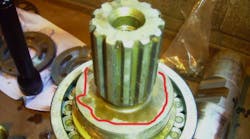Would you part with $70 to save $70,000? This is a 'no brainer' for most of us. Well, here's a story for you:
I recently conducted failure analysis and a reliability audit on a 300 kilowatt (400HP) hydrostatic transmission. The hydraulic system was running a synthetic ester, biodegradable hydraulic fluid. This $45/gallon hydraulic fluid had been destroyed in under 12 months and a set of pumps shortly after. So with $20,000 of hydraulic fluid and $50,000 of pumps ruined in short order, my client was understandably wondering what went wrong.
The system was built and installed by a reputable firm. From a hydraulic engineering perspective the circuit was adequately designed and the system well built. But from a maintenance and reliability perspective it left a lot to be desired. My client, the end user, didn't have a lot of experience with hydraulic equipment and was reliant on the company that built the system to guide them on its maintenance.
An oil analysis program had been set up, but it seems the only thing anyone was taking any notice of was particle contamination. If you've been reading this blog for a while, you'll know there's a lot more to hydraulic equipment reliability than just monitoring and controlling hard particle counts.
All the warning signs pointing to oxidative failure of the oil went unnoticed. The oil started polymerizing, coating internal components with sludge. These gum-like deposits block lubrication passages, reduce heat transfer and cause valve stiction. The oxidation process diminishes foaming resistance and air release properties of the oil, which in turn causes damage through aeration and gaseous cavitation.
By the time I got involved, the original set of pumps had already failed and the hydraulic fluid had an Acid Number of 10 and water content of 6,500 ppm. So I set about establishing the root cause of failure and instigating measures to ensure it didn't happen again.
It's not rocket science. But the problem for my client was the information they needed to prevent this maintenance disaster is not widely available. You won't find it in the machine manual and it's not taught in everyday, how-it-works, hydraulics classes. As a consequence, most owners, operators, mechanics, technicians and engineers are clueless when it comes to proper maintenance of hydraulic equipment. It's not their fault - they just haven't been given the opportunity to learn.
The principles I applied and the procedures I put in place to prevent a recurrence of the failures described above, are the same ones I outline in The Hydraulic Maintenance Handbook. Had my client had this information and applied it diligently at the outset, they could have saved more than $70,000 - and a lot of downtime and aggravation.
The bottom line is, failing to properly monitor the condition of your hydraulic oil can be a costly mistake. And to discover six other costly mistakes you want to be sure to avoid with your hydraulic equipment, get "Six Costly Mistakes Most Hydraulics Users Make... And How You Can Avoid Them!" available for FREE download here.

Continue Reading
Continue Reading
BOOK 2, CHAPTER 12: Fluid Motor Circuits
March 18, 2009
Motor leakage variations
Oct. 18, 2006
Sponsored Recommendations
Sponsored Recommendations
All-In-One DC-UPS Power Solutions
March 13, 2024
Motor Disconnect Switches
March 13, 2024
Industrial Straight-Through Cable Gland
March 13, 2024
